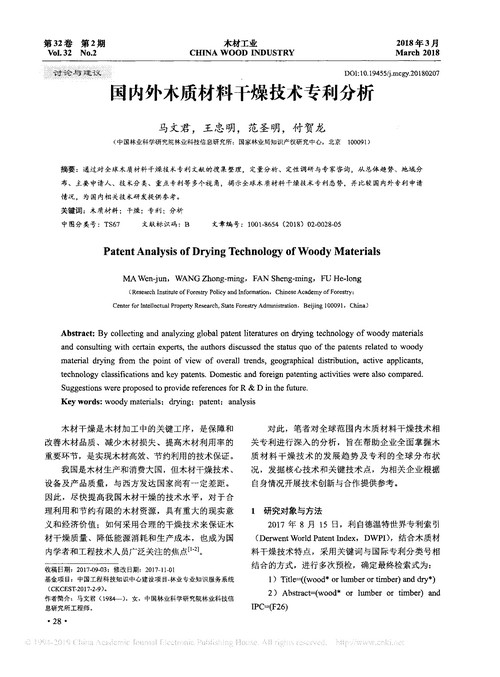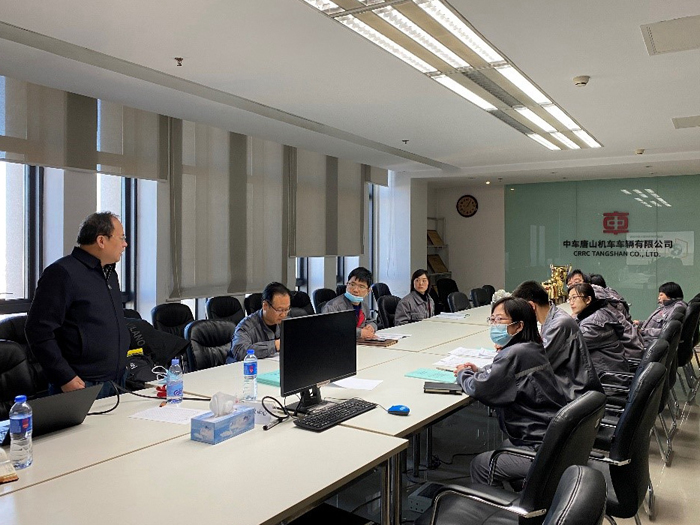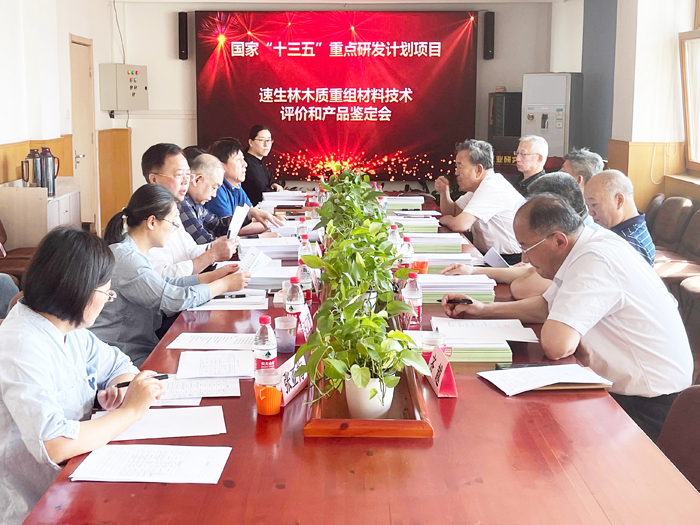
木质材料等离子体改性研究进展
编号
lyqk005980


中文标题
木质材料等离子体改性研究进展


作者单位
西南林业大学云南省木材胶黏剂及胶合制品重点实验室,昆明 650224,西南林业大学云南省木材胶黏剂及胶合制品重点实验室,昆明 650224


期刊名称
世界林业研究


年份
2017


卷号
30


期号
5


栏目编号
1


栏目名称
专题论述


中文摘要
等离子体改性技术作为一种高效、绿色的处理工艺已广泛应用于催化剂合成、表面活化、化合物镀膜等研究及应用领域。其对木质材料改性研究从上世纪90年代至今已取得许多重要的实验及理论成果,可综述为:1)木质材料等离子体改性的特性;2)木质材料等离子体改性的机理;3)等离子体改性木质材料的设备及工艺。文中在整理近年文献资料的基础上分析了文献中相互矛盾的结论,并对未来等离子体改性木质材料的研究方向提出建议。


基金项目
“十二五”国家科技支撑计划项目(2015BAD14B03)。


英文标题
Research Advances on Wood Material Modification by Plasma Treatment


作者英文名
Duan Zhigang and Du Guanben


单位英文名
Yunnan Provincial Key Laboratory of Wood Adhesives and Glued Products,Southwest Forestry University,Kunming 650224,China and Yunnan Provincial Key Laboratory of Wood Adhesives and Glued Products,Southwest Forestry University,Kunming 650224,China


英文摘要
The plasma treatment is an efficient and green method which has been widely adopted in the research and application of catalyst synthetic, surface activation and compound coating, etc. The wood material modification by plasma treatment has made many important theoretical and experimental achievements since the 1990s, including:(1) the characteristics of wood materials by plasma modification; (2) the mechanism of wood materials by plasma modification; (3) the process and equipment of wood materials by plasma modification. Based on the recent literature, we analyzed the conflicting conclusion systematically, and put forward some suggestions for future research in plasma modification of wood materials.


英文关键词
wood material;plasma treatment;surface modification


起始页码
51


截止页码
55


投稿时间
2017/4/18


分类号
S781


DOI
10.13348/j.cnki.sjlyyj.2017.0051.y


参考文献
[1] 雷得定, 周军浩, 刘波, 等.木材改性技术的现状与发展趋势[J].木材工业, 2009, 23(1):37-40.
[2] 李建章, 周文瑞, 张德荣, 等.世界木材改性的研究与应用进展:木材改性的基础与理论模式[J].国际木业, 2002, 32(3):17-19.
[3] VOLOKITIN G G, SKRIPNIKOVA N K, SINITSYN V A, et al. Plasma treatment of wood[J].Thermophysics and Aeromechanics, 2016, 23(1):119-124.
[4] CHO D, SJOBLOM E. Plasma treatment on wood for construction material[C].The 16th American Chemical Society, Washington DC, 1990.
[5] NOVAK I, POPELKA A,ŠPITALSK Z, et al.Investigation of beech wood modified by radio-frequency discharge plasma[J].Vacuum, 2015, 119(5):88-94.
[6] AVRAM A, COVLEA V, MATEI A, et al. Impact of RF and DC plasma on wood structure[J].Romanian Reports in Physics, 2015, 67(3):1028-1039.
[7] KRÁL P,RÁHEL J, STUPAVSKÁM, et al. XPS depth profile of plasma-activated surface of beech wood (Fagus sylvatica) and its impact on polyvinyl acetate tensile shear bond strength[J].Wood Science and Technology, 2014, 49(2):319-330.
[8] MAGALHAES W L E, De SOUZA M F. Solid softwood coated with plasma-polymer for water repellence[J]. Surface and Coatings Technology, 2002, 155(1):11-15.
[9] BENTE M, AVRAMIDIS G, FORSTER S, et al.Wood surface modification in dielectric barrier discharges at atmospheric pressure for creating water repellent characteristics[J]. Holz Als Roh-Und Werkstoff, 2004, 62(3):157-163.
[10] MENENDEZ J, MENENDEZ E, IGLESIAS M, et al.Modification of the surface chemistry of active carbons by means of microwave-induced treatments[J].Carbon, 1999, 37(7):1115-1121.
[11] WASCHER R,SCHULZE N,AVRAMIDIS G,et al.Increasing the water uptake of wood veneers through plasma treatment at atmospheric pressure[J]. European Journal of Wood and Wood Products,2014,72(5):685-687.
[12] HAASE J, EVANS P. Plasma modification of wood surfaces to improve the performance of clear coatings[C].The Fifth European Conference on Wood Modification,Latvian State Inst of Wood Chemistry, Riga, 2010.
[13] WASCHER R, LEIKE N, AVRAMIDIS G, et al.Improved DMDHEU uptake of beech veneers after plasma treatment at atmospheric pressure[J]. European Journal of Wood and Wood Products,2015,73(4):433-437.
[14] ACDA M N, DEVERA E E, CABANGON R J, et al. Effects of plasma modification on adhesion properties of wood[J]. International Journal of Adhesion and Adhesives, 2011, 32(10):70-75.
[15] DENES A R, YOUNG R A. Reduction of weathering degradation of wood through plasma-polymer coating[J]. Holzforschung, 1999, 53(6):632-640.
[16] BUSNEL F, BLANCHARD V, GENT J P R, et al. Modification of sugar maple (Acer saccharum) and black spruce (Picea mariana) wood surfaces in a Dielectric Barrier Discharge (DBD) at atmospheric pressure[J]. Journal of Adhesion Science and Technology, 2010, 24(8/9/10):1401-1413.
[17] MERTENS N, WOLKENHAUER A, LECK M, et al. UV laser ablation and plasma treatment of wooden surfaces:a comparing investigation[J]. Laser Physics Letters, 2006, 3(8):380-384.
[18] GASC N-GARRIDO P, MAINUSCH N, MILITZ H, et al. Effects of copper-plasma deposition on weathering properties of wood surfaces[J]. Applied Surface Science, 2016, 366:112-119.
[19] WOLKENHAUER A, AVRAMIDIS G, HAUSWALD E, et al. Sanding vs. plasma treatment of aged wood:a comparison with respect to surface energy[J]. International Journal of Adhesion and Adhesives, 2009, 29(1):18-22.
[20] ASANDULESA M, TOPALA I, DUMITRASCU N. Effect of helium DBD plasma treatment on the surface of wood samples[J]. Holzforschung, 2010, 64(2):223-227.
[21] ALTGEN D, AVRAMIDIS G, VI L W, et al. The effect of air plasma treatment at atmospheric pressure on thermally modified wood surfaces[J]. Wood Science and Technology, 2016, 50(6):1227-1241.
[22] JAMALI A, EVANS P. Etching of wood surfaces by glow discharge plasma[J]. Wood Science and Technology, 2011, 45(1):169-182.
[23] 王洪艳, 杜官本, 郑荣波, 等. 氧气和氮气冷离子体处理对木材胶合性能的影响(英文)[J].Agricultural Science & Technology, 2014, 17(3):392-394.
[24] WASCHER R, AVRAMIDIS G, VETTER U, et al. Plasma induced effects within the bulk material of wood veneers[J]. Surface and Coatings Technology, 2014, 259:62-67.
[25] 杜官本, 杨忠, 黄林荣, 等. 微波等离子体处理木材表面接枝甲基丙烯酸甲酯的研究[J]. 林产化学与工业, 2003, 24(1):25-29.
[26] 黄河浪, 赵明, 董丽君, 等. 低温冷等离子体对不同含水率杨木单板表面改性的初步研究[J]. 林产工业, 2010, 37(3):20-22.
[27] LEVASSEUR O, KUMAR GANGWAR R, PROFILI J, et al. Influence of substrate outgassing on the plasma properties during wood treatment in He dielectric barrier discharges at atmospheric pressure[J].Plasma Processes and Polymers,2016.DOI:10.1002/ppap.201600172.
[28] 杜官本,华毓坤.微波等离子体环境下木材表面蚀刻[J].林业科学, 1999, 35(2):95-99.


PDF全文
浏览全文


-
相关记录
更多
- 基于黏结剂喷射的木质材料增材制造技术研究进展 2023
- 木质材料在黄河“非遗”数字化展示空间设计中的应用 2022
- 声发射技术在木质材料损伤监测中的应用研究进展 2022
- 作品名称:宅以木作——基于木质材料的空间营造设计 2022
- 分子筛在木材阻燃中的应用 2014
- 木材等离子体改性研究进展 2008
 打印
打印


